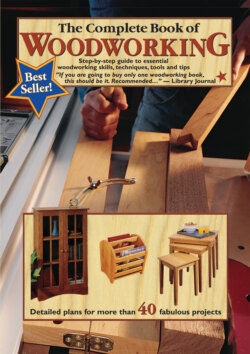Читать книгу Draw Manga - Tom Carpenter - Страница 23
Moisture & Wood Movement
ОглавлениеRegardless of whether boards are air-or kiln-dried once they are cut from a log, lumber will continue to seek what is known as equilibrium moisture content (EMC): it will absorb moisture or dry out until its moisture content matches the relative humidity in the surrounding air. A kiln-dried board will never absorb as much moisture as it initially had when it was green, but its sponge-like qualities cannot be stopped, even when a wood finish is applied.
The amount of moisture a board contains at the lumberyard is measured in percentages, which range from 6% to more than 20%. Framing lumber should be less than 18% moisture when purchased (about 14% is ideal), while stock destined for furniture or casework should be down around 6 to 8%. Moisture percentages are measured in terms of water weight vs. wood weight, not according to volume.
The only accurate way to check this is with a moisture meter (See Evaluating Moisture Content, below), a small electronic tool with two sharp pins that are inserted into a freshly cut surface of the wood (old cuts dry quickly and give a false reading, so a fresh cut is essential). Most fine hardwood vendors will loan you a meter to examine their stock before you buy, or you can ask them to take a reading in your presence.
EVALUATING MOISTURE CONTENT
A moisture meter will tell you immediately the moisture content of a board. The red glowing light on this meter indicates the moisture content in this board to be 10%, an acceptable level for cutting and for project use. Calibrated moisture meters aren’t cheap, but you may want to invest in one if plan to do fine furniture work or if the humidity in your shop fluctuates widely. It’s also a good idea to test the moisture content of air-dried lumber if you purchase it directly from the mill. Be sure to test the wood on a fresh-cut edge or end—old edges dry quickly and will not provide an accurate reading.
Wood expands and contracts in response to changes in moisture and temperature. Tangential movement (A) occurs parallel to the growth rings, while radial movement (B) happens across the rings. Wood moves very little along its length (C). Generally a board’s tangential movement is about double its radial movement.
As wood absorbs moisture from the air, it expands, and as the moisture evaporates, it will contract. You may be surprised to learn that wood basically moves parallel to the growth rings (tangentially) and across the rings (radially), but almost never along it (longitudinally). Therefore, in a standard plain-sawn board (see Lumber Cuts, previous page), expansion or contraction essentially occur in just two directions: width and thickness. Movement across the width is normally about twice that in thickness. The “greener” the board, the more it will move. It is critical, when designing and building woodworking projects, to consider how these forces of expansion and contraction will affect your project; they cannot be entirely eliminated.
